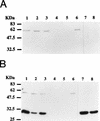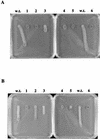Isolation of Rhodospirillum centenum mutants defective in phototactic colony motility by transposon mutagenesis
- PMID: 9495765
- PMCID: PMC107014
- DOI: 10.1128/JB.180.5.1248-1255.1998
Isolation of Rhodospirillum centenum mutants defective in phototactic colony motility by transposon mutagenesis
Abstract
The purple photosynthetic bacterium Rhodospirillum centenum is capable of forming swarm colonies that rapidly migrate toward or away from light, depending on the wavelength of excitation. To identify components specific for photoperception, we conducted mini-Tn5-mediated mutagenesis and screened approximately 23,000 transposition events for mutants that failed to respond to either continuous illumination or to a step down in light intensity. A majority of the ca. 250 mutants identified lost the ability to form motile swarm cells on an agar surface. These cells appeared to contain defects in the synthesis or assembly of surface-induced lateral flagella. Another large fraction of mutants that were unresponsive to light were shown to be defective in the formation of a functional photosynthetic apparatus. Several photosensory mutants also were obtained with defects in the perception and transmission of light signals. Twelve mutants in this class were shown to contain disruptions in a chemotaxis operon, and five mutants contained disruptions of components unique to photoperception. It was shown that screening for photosensory defective R. centenum swarm colonies is an effective method for genetic dissection of the mechanism of light sensing in eubacteria.
Figures






References
-
- Allison C, Hughes C. Closely linked genetic loci required for swarm cell differentiation and multicellular migration by Proteus mirabilis. Mol Microbiol. 1991;5:1975–1982. - PubMed
-
- Armitage J P, Evans M C W. The reaction center in the phototactic and chemotactic responses of Rhodopseudomonas sphaeroides. FEMS Microbiol Lett. 1981;11:89–92.
-
- Bai Y. Characterization of phototactic mutants produced by mini-Tn5 transposon mutagenesis. M.S. thesis. Bloomington: Indiana University; 1995.
Publication types
MeSH terms
Substances
LinkOut - more resources
Full Text Sources

